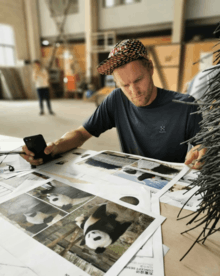Florentijn Hofman
Florentijn Hofman (born 16 April 1977) is a Dutch artist who creates playful urban installations like the Rubber Duck and the HippopoThames, a 2014 installation on the River Thames in London.[1]
Florentijn Hofman | |
|---|---|
 | |
| Born | 16 April 1977 Delfzijl, Netherlands |
| Nationality | Dutch |
Notable work | Rubber Duck |
| Children | 4 |
| Website | florentijnhofman |
.jpg)
Life and career
Hofman was born on 16 April 1977 in Delfzijl in the Netherlands. He attended primary and secondary school in Emmen. He studied arts at the art academy of Kampen. He earned a master's degree in art in Weissensee, Berlin.[2] He lives in Rotterdam, the Netherlands, and has four children.[3]
Artwork
He mostly works on reproducing large versions of everyday objects, such as laminate flooring and flip-flops. With these sculptures, he wants to make people's lives happier. The purpose of his art is to promote the message of healing.[4] In 2005, he created giant bird for the 2005 Crossing Border Festival, where it was perched atop The Hague City Hall. In 2006, Rotterdam's Natural History Museum, whose staff hoped that the statue would prevent birds from flying into the buildings glass windows.[5]
His best-known work, Rubber Duck, made its debut in 2007 in Saint-Nazaire, France, and has since appeared in many cities around the world. In 2011 the Hyōgo Prefectural Museum of Art in Kobe, Japan, commissioned him to create another work, which became the Kobe Frog. The museum had initially wanted Rubber Duck to be placed on its roof, which Hofman declined.[6] In 2014, he introduced HippopoThames in London on the River Thames, and Moon Rabbit in Taiwan, ahead of a land-art festival taking place in Taoyuan. In 2016, he created a floating fish sculpture in Wuzhen, China,[7] and two animal sculptures called PETS for Amsterdam's Schiphol Airport.[8] In 2017, he created the Kraken playground in Shenzen, China, on a site that had been occupied by a former soviet aircraft carrier.
Hofman's sculptures are temporary—even the Rubber Duck, which makes appearances in cities around the world, is created anew locally. He likes this because wealthy private collectors or those who see art solely as an investment are not able to buy his sculptures. In a 2013 interview, he stated "I'm not a big believer in 'art is forever'. A lot of art is bought by people who have money. But I'm a supporter of public art in public spaces."[6] He is also strictly against commercialization of his art, and only sells miniature replicas, whose profits go to local nonprofits. In Hong Kong in 2013, it was the Joyful (Mental Health) Foundation; in Pittsburgh in 2014, it was the Pittsburgh Cultural Trust.[6]
Intellectual property
Hofman's strict stance on commercialization translates to merchandise as well. He canceled an appearance in Keelung, Taiwan, to protest the fact that the organizers had turned the sculpture into a "commercial circus".[9] This led to an op-ed headlined "Copycat Culture Must Stop" in the Global Times, an offshoot of the People's Daily, the official newspaper of the Chinese Communist Party.[10] On the other hand, he has been criticized because "reproductions do not infringe on an intellectual copyright that Hofman can't legitimately claim as his own".[11]
Gallery
- Crow at Natural History Museum Rotterdam
 Paper Boats in Rotterdam
Paper Boats in Rotterdam.jpg) Moon Rabbit at Taoyuan, 2014
Moon Rabbit at Taoyuan, 2014- HippopoThames in London, 2014
See also
References
- Azzarello, Nina (4 September 2014). "Florentijn Hofman Floats Huge Hippopotamus Down the River Thames". designboom. Retrieved 13 February 2018.
- "Curriculum Vitae", Florentijn Hofman. Retrieved on 2013-11-01.
- Meija, Carlos (15 May 2017). "Artist Florentijn Hofman Makes the World's Biggest Toys". Fatherly. Retrieved 13 February 2018.
- "Giant rubber duck enthralls citizens despite Lotte controversy". Yonhap News Agency. Retrieved 14 March 2016.
- "Rotterdam Nature Museum Fitted With Giant Crow". Powered by Birds. 19 April 2006. Retrieved 14 February 2018.
- Chow, Vivienne (6 May 2013). "Florentijn Hofman, Rubber Duck artist, is man of principles". South China Morning Post. Retrieved 13 February 2018.
- Azzarello, Nina (7 April 2016). "florentijn hofman forms floating fish from foam kick boards in wuzhen, china". designboom. Retrieved 14 February 2018.
- Corboy, Peter (29 October 2016). "florentijn hofman's PETS provide a warm welcome at amsterdam's schiphol airport". designboom. Retrieved 14 February 2018.
- "Keelung Duck Exhibition Ruffles Artist's Feathers". Taipei Times. 22 December 2013. Retrieved 14 February 2018.
- Zhang Yu (19 June 2013). "Copycat Culture Must Stop". Global Times. Retrieved 14 February 2018.
- Capps, Kriston (4 September 2014). "The 'Rubber Duck' Artist Must Be Stopped". CityLab. Retrieved 13 February 2018.